 W
WAbumi (鐙), Japanese stirrups, were used in Japan as early as the 5th century, and were a necessary component along with the Japanese saddle (kura) for the use of horses in warfare. Abumi became the type of stirrup used by the samurai class of feudal Japan.
 W
WArtillery in Japan was first used during the Sengoku period in the 16th century; and its use has continued to develop.
 W
WThe bajō-zutsu (馬上筒) was a tanegashima in the form of a pistol. Bajō-zutsu were used by mounted samurai in feudal Japan.
 W
WBo hiya is the Japanese version of the fire arrow. Bo-hiya were used in ancient Japan and by the samurai class of feudal Japan.
 W
WThe daishō —literally "big-little"—is a Japanese term for a matched pair of traditionally made Japanese swords (nihonto) worn by the samurai class in feudal Japan.
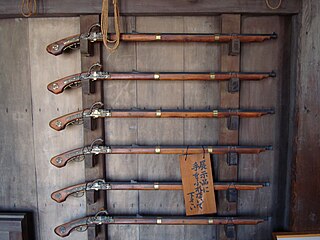 W
WFirearms were introduced to Japan in the 13th century by the Chinese, but saw little use. Portuguese firearms were introduced in 1543, and intense development followed, with strong local manufacture during the period of conflicts of the late 16th century. Hōjutsu, the art of gunnery, is the Japanese martial art dedicated to firearms usage.
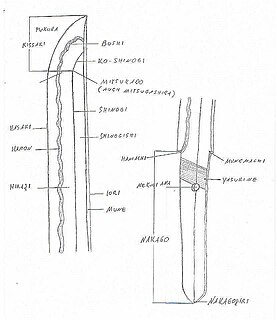 W
WThis is the glossary of Japanese swords, including major terms the casual reader might find useful in understanding articles on Japanese swords. Within definitions, words set in boldface are defined elsewhere in the glossary.
 W
WHata-jirushi (旗印) were the most common of war banners used on the medieval Japanese battlefield. The term can be translated to literally mean symbol flag, marker banner, or the like. Unlike the later nobori, which were stiffened, these banners were simple streamers attached to a shaft by a horizontal cross-piece. Later, some hata-jirushi were hemmed on the sides to create a sleeve for a pole on the side and top, or had pieces of fabric attaching their side and top to poles to make the banners visible from the front. There are two variants of the Hata-jirushi: One end of the cross-piece was attached to the shaft or the cross-piece was suspended from the shaft, similar to the Vexillum.
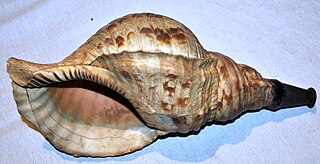 W
WHoragai are large conch shells, usually from Charonia tritonis, that have been used as trumpets in Japan for many centuries. The instrument, which has served a number of purposes throughout Japanese history, has been given a number of Japanese names depending on its function. Special schools still teach students to play the traditional music associated with the conch.
 W
WA horo (母衣) was a type of cloak or garment attached to the back of the armour worn by samurai on the battlefields of feudal Japan.
 W
WScholars agree that Japanese armour first appeared in the 4th century, with the discovery of the cuirass and basic helmets in graves. It is thought they originated from China via Korea. During the Heian period (794-1185), the unique Japanese samurai armour ō-yoroi and dō-maru appeared. The Japanese cuirass evolved into the more familiar style of body armour worn by the samurai known as the dou or dō, with the use of leather straps (nerigawa), and lacquer for weatherproofing. Leather and/or iron scales were also used to construct samurai armours, with leather and eventually silk lace used to connect the individual scales (kozane) of these cuirasses. In the 16th century, Japan began trading with Europe, during what would become known as the Nanban trade. This was the first time matchlock muskets were imported, and as they became mass-produced domestically, samurai needed lighter and more protective armour. As a result, a new style of armour called tosei-gusoku (gusoku), which means modern armour, appeared. When a united Japan entered the peaceful Edo period, samurai continued to use both plate and lamellar armour as a symbol of their status.
 W
WA Japanese sword is one of several types of traditionally made swords from Japan. Bronze swords were made as early as the Yayoi period, though most people generally refer to the curved blades made after the Heian period when speaking of "Japanese swords". There are many types of Japanese swords that differ by size, shape, field of application and method of manufacture. Some of the more commonly known types of Japanese swords are the katana, tachi, odachi, wakizashi, and tantō.
 W
WJapanese sword mountings are the various housings and associated fittings that hold the blade of a Japanese sword when it is being worn or stored. Koshirae (拵え) refers to the ornate mountings of a Japanese sword used when the sword blade is being worn by its owner, whereas the shirasaya is a plain undecorated wooden mounting composed of a saya and tsuka that the sword blade is stored in when not being used.
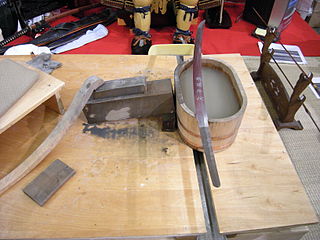 W
WSword polishing is part of Japanese swordsmithing where a blade is polished after forging. It gives the shining appearance and beauty to the sword.
 W
WJapanese swordsmithing is the labour-intensive bladesmithing process developed in Japan for forging traditionally made bladed weapons (nihonto) including katana, wakizashi, tantō, yari, naginata, nagamaki, tachi, nodachi, ōdachi, kodachi, and ya (arrow).
 W
WThe Japanese war fan, or tessen, is a weaponized Japanese hand fan designed for use in warfare. Several types of war fans were used by the samurai class of feudal Japan and each had a different look and purpose.
 W
WKabura-ya is a type of Japanese arrow used by the samurai class of feudal Japan. Kabura-ya were arrows which whistled when shot and were used in ritual archery exchanges before formal medieval battles.
 W
WKaginawa (鈎縄/鉤縄) is the combination of the words kagi meaning hook and nawa meaning rope. The kaginawa is a type of grappling hook used as a tool in feudal Japan by the samurai class, their retainers, foot soldiers and reportedly by ninja. Kaginawa have several configurations, from one to four hooks. The kagi would be attached to a nawa of varying length; this was then used to scale a rather large wall, to secure a boat, or for hanging up armor and other equipment during the night. Kaginawa were regularly used during various sieges of miscellaneous castles. The nawa was attached to a ring on one end which could be used to hang it from a saddle.
 W
WThe kama is a traditional Japanese farming implement similar to a sickle used for reaping crops and also employed as a weapon. It is often included in weapon training segments of martial arts. Sometimes referred to as kai or "double kai," kama made with intentionally dull blades for kata demonstration purposes are referred to as kata kai.
 W
WA kasa is a term used for any one of several traditional Japanese hats. These include amigasa and jingasa.
 W
WKate-bukuro a commonly used component within samurai attire during periods such as the Sengoku period of Japan. A Kate-bukuro was a provisional bag used by the samurai class and their retainers. For ordinary officers however, these provisional bags had been called by the name, Koshi-zuto. These types of bags were made of twisted paper strings within the style of fine basketwork, and measures around 1 shaku to 9 sun. These bags will then be carried within the right side of the waist. Another bag is also advised to be carried, which is 3 or 4 go of rice that is raw. Baked rice is also regularly employed when amongst cold weather due to the emission of heat.
 W
WKiseru (煙管) is a Japanese smoking pipe traditionally used for smoking a small serving of kizami, a finely shredded tobacco product resembling hair.
 W
WKubi bukuro (首袋) is a type of string bag used by the samurai class primarily during the Sengoku period of Japan. Kubi bukuro literally means 'head bag'. This type of bag was made out of net to carry a severed enemy head. When walking, it is hung it from the waist. When the owner is riding a horse, the bag is fastened to the saddle. Samurai commanders carried many of these Kubi bukuro.
 W
WKura (鞍), is the generic name for the Japanese saddle. The word "kura" is most commonly associated with the saddle used by the samurai class of feudal Japan. Over time the Japanese added elements of their own until the Japanese saddle became an identifiable style, also known as the samurai saddle.
 W
WThe term makibishi refers to the Japanese version of the caltrop. The tool (igadama) is a sharp spiked object that was used in feudal Japan to slow down pursuers and also was used in the defense of samurai fortifications.
 W
WAn ōdzutsu was a type of artillery used during the Sengoku Jidai and the early Edo period in Japan.
 W
WOno or masakari is the Japanese word for "axe", and is used to describe various tools of similar structure. As with axes in other cultures, ono are sometimes employed as weapons. Many existing examples of this particular weapon are associated with the sōhei or yamabushi, who also adapt other agricultural tools as weapons, although samurai are also pictured as using ono in woodblock prints. Ono that were specifically designed for military use are of extreme rarity. The weapon version of the ono is described as having "a very large head with a very convex cutting edge and a large scroll-shaped peen opposite it. It has a sheath covering only the edge of the blade. The entire length is nearly six feet".
 W
WAn ōtsuchi is a large wooden war mallet used by the samurai class of feudal Japan. The ōtsuchi had a shaft of about 6 feet (1.8 m) much like the ono. It was mainly used for door breaching.
 W
WA saihai was a baton carried by samurai commanders in feudal Japan, now used by Kannushi in formal settings. The saihai or sai-hai was a sign of rank and a signal device.
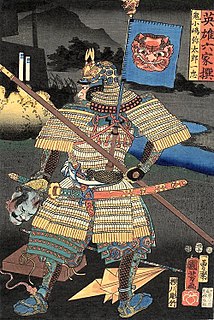 W
WSashimono were small banners historically worn by soldiers in feudal Japan, for identification during battles.
 W
WA shinai (竹刀) is a Japanese sword typically made of bamboo used for practice and competition in kendo. Shinai are also used in other martial arts, but may be styled differently from kendo shinai, and represented with different characters. The light, soft wood used in a shinai distinguishes it from other wooden swords such as a bokken, which is generally made of heavier, sturdier wood.
 W
WA shuriken is a Japanese concealed weapon that was used as a hidden dagger or metsubushi to distract or misdirect.
 W
WTanegashima , most often called in Japanese and sometimes in English hinawajū , was a type of matchlock-configured arquebus firearm introduced to Japan through the Portuguese Empire in 1543. Tanegashima were used by the samurai class and their ashigaru "foot soldiers", and within a few years the introduction of the tanegashima in battle changed the way war was fought in Japan forever.
 W
WA tantō is one of the traditionally made Japanese swords that were worn by the samurai class of feudal Japan. The tantō dates to the Heian period, when it was mainly used as a weapon but evolved in design over the years to become more ornate. Tantō were used in traditional martial arts (tantojutsu). The term has seen a resurgence in the West since the 1980s as a point style of modern tactical knives, designed for piercing or stabbing.
 W
WThe Wolverhampton Art Gallery, located in Wolverhampton, England, has a collection of 114 historic tsuba from Japan. The tsuba is usually a round guard at the end of the grip of bladed Japanese weapons, like the katana and its various variations. Items in the collection range from the Momoyama period to the end of the Edo period.
 W
WUma-jirushi were massive flags used in feudal Japan to identify a daimyō or equally important military commander on the field of battle. They came into prominence during the Sengoku period. While many were simply large flags, not very different from sashimono or hata-jirushi, most were three-dimensional figures, more like kites, and in the shape of bells, gongs, umbrellas, or streamers.
 W
WThe wakizashi is one of the traditionally made Japanese swords worn by the samurai in feudal Japan.
 W
WYebira, Ebira and Shiko are types of quiver used in Japanese archery. The quiver is unusual in that in some cases, it may have open sides, while the arrows are held in the quiver by the tips which sit on a rest at the base of the ebira, and a rib that composes the upper part and keeps them in place.
 W
WYumi is the Japanese term for a bow. As used in English, 'yumi' refers more specifically to traditional Japanese asymmetrical bows, and includes the longer daikyū and the shorter hankyū used in the practice of kyūdō and kyūjutsu, or Japanese archery.